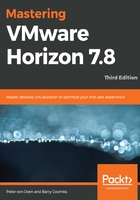
Introducing VDI and VMware Horizon 7
n the first chapter of this book, we are going to start by discussing what we mean when we talk about Virtual Desktop Infrastructure (VDI) and define exactly what this means. Once we have defined this, we will go on to discuss the specifics of it in the context of the VMware Horizon solution.
Throughout this book we have used a number of screenshots to demonstrate installation and configuration of Horizon, using the example lab environment. These screenshots are taken from Horizon 7 version 7.6, however, the latest 7.8 version is exactly the same with the exception of the version number shown on the screenshot, and in some cases the Horizon logo. The process and steps shown remain exactly the same.
Horizon provides the foundation to VMware's End User Computing (EUC) solution for delivering desktops and applications. VMware first entered the VDI market about 16 years ago, when they demonstrated the concept of virtualizing a desktop operating system by using their success in the server virtualization market that is now becoming a more mature and prevalent technology. Taking some of the very same principles that are used in server virtualization, and instead applying them to a desktop operating system, VMware was able to create a centrally-managed, virtualized desktop solution that would lower the overall cost of desktop computing and increase security.
In this chapter, we are going to cover the following topics:
- What is VDI, and how does it work?
- A history of VMware and VDI
- VMware Horizon editions and licensing options
Before we get into discussing specific product features and functionality, let's define what we mean when we talk about VDI. We'll then take a brief stroll down memory lane and look at where and how it all started for VMware.